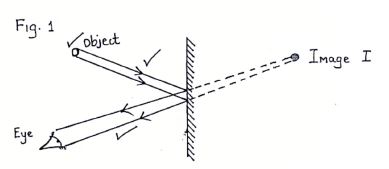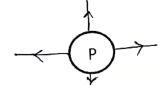Instructions to Candidates
- Write your name, admission number, class and signature in the spaces provided at the top of the page. This paper consists of two sections; A and
- Answer ALL the questions in the spaces provided.
- Mathematical tables and electronic calculator may be used.
- You may use the following constants where necessary:-
- This paper consists of 11 printed pages.
- Candidates should answer the questions in English.
- g = 10 N/kg, or m/s2
- e = 1.6 x 10-19C
- c= 3.0 x 108 m/s
FOR EXAMINER’S USE ONLY
|
SECTION |
QUESTIONS |
MAXIMUM SCORE |
CANDIDATE’S SCORE |
|
A |
1 – 07 |
25 |
|
|
B |
08 |
14 |
|
|
|
09 |
15 |
|
|
|
10 |
13 |
|
|
|
11 |
13 |
|
|
TOTAL SCORE |
80 |
||

QUESTIONS
SECTION A
- Fig.1 below shows an image of an object reflected on a plane mirror. Using ray diagram, locate the position of the object. (3mks)

- A mirror is rotated through an angle of 15o, find the angle through which the reflected ray is rotated. (1mk)
- Fig.1 below shows an image of an object reflected on a plane mirror. Using ray diagram, locate the position of the object. (3mks)
- A strongly charged glass rod is brought close to a neutral electroscope. State and explain the observations made. (2mks)
- Fig 2 below shows a circuit made by a form 2 student.
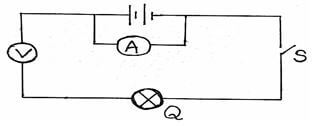
- State and explain the observation made on component Q when switch S closed. (2mks)
- A current of 1A flows through a circuit for three minutes. Calculate the number of electrons that flows through a point in the circuit. (charge of an electron = 1.6x10-19C) (3mks)
- Fig 3 below show a copper rod placed inside a solenoid.

- State and explain the observation made when the rod is removed after sometime and dipped into a container with iron fillings (2mks)
- Using domain theory, distinguish between magnetic and non-magnetic materials (1mk)
- Fig 4 below shows rays incident on a curved mirror.
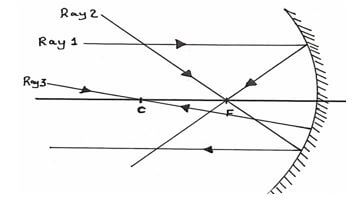
State the rules for drawing the ray 1, ray 2 and ray 3. (3mks)
Ray1………………………………………………………………………………………
Ray 2………………………………………………………………………………………
Ray3……………………………………………………………………………………… -
- Define interference as used the waves (1mk)
- The fig.5 below shows two ways of monochromatic light incident on two adjacent slit S1, and S2
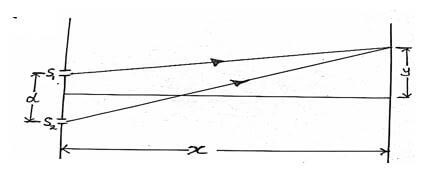
State what is observed on the screen when:- The distance x is increased. (1mk)
- The slit separation d is reduced. (1mk)
- The white light is used. (1mk)
- The fig 6 below shows a circuit with a heating element L of resistance 30Ω immersed in a container of water.
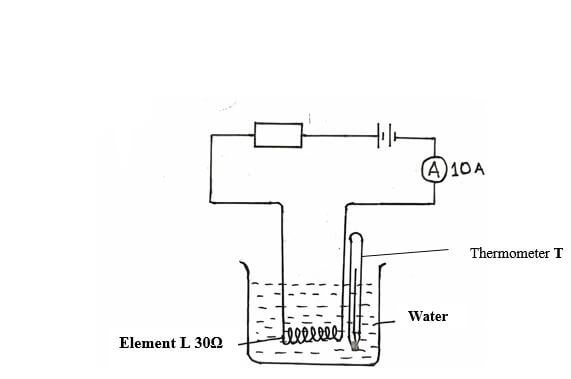
- If current in the circuit is 10A and the switch is on for 2minutes. Calculate the heat energy absorbed by the water in kilojoules. (ignore heat gained by the container) (3mks)
- State the adjustment made on the element L so that high temperature is recorded by the thermometer T in the same duration of time. (1mks)
SECTION B (55MKS)
-
- A gun was fired at a point 150m from a vertical wall while listening to an echo. The echo coincides with the sound from the gun at each time the gun is fired. After 20 successive shots, time recorded was 18.5seconds. Determine:
- Time taken for one echo to be heard (2mks)
- Speed of sound in air (3mks)
- What difference would you expect if the gun was short on a colder day (1mks)
- Sound is classified as a longitudinal mechanical wave, explain why sound is classified as
- A longitudinal waves (1mk)
- A mechanical waves (1mk)
- Fig 7 below shows a progressive waves of frequency 10Hz

Determine the speed of the wave (3mks) - Calculate the wavelength of the KBC FM radio wave transmitted at a frequency of 95.6MHz. (v = 3.0 x 108m/s) (3mks)
- A gun was fired at a point 150m from a vertical wall while listening to an echo. The echo coincides with the sound from the gun at each time the gun is fired. After 20 successive shots, time recorded was 18.5seconds. Determine:
-
- The figure 8 below shows a narrow beam of white light passed onto a glass Prism.

- What is the name of the phenomenon represented in the diagram? (1mk)
- Name the colour at X and Y. (2mk)
X: .............................................................
Y: ……………………………………… - Give a reason for your answer in part (ii) above.(2mks)
- What is the purpose of the slit? (1mk)
- Figure 9 below shows the path of ray of yellow light through a glass prism. The speed of yellow light in the prism is 1.8 x 108 m/s.

- Determine the refractive index of the prism material (Speed of light in vacuum, C= 3.0 x 108 m/s)(3mks)
- Given that r = 31.20, determine the angle θ. (3mks)
- Show on the same diagram, the critical angle c and hence determine its value. (3mks)
- The figure 8 below shows a narrow beam of white light passed onto a glass Prism.
- Fig 10 below shows a circuit in which a bulb. A resister R, a voltmeter V, a light dependent resistor(LDR) and ammeters A1 and A2 of negligible resistors are connected
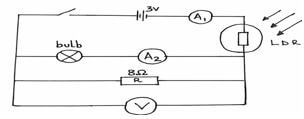
R has a resistance of 8Ω when the switch is closed with no source of light. Ammeter A2 reads 0.12A while the voltmeter reads 2.4V- Determine;
- The current passing through R (2mk)
- The resistance of the bulb (2mks)
- Light is now shone onto the Light Dependent resistor (LDR)
- State how this will affect the reading of ammeter A1 (1mk)
- Explain your answer in b) (i) above (2mks)
- If the LDR has a resistance of 10Ω at room temperature, determine:
- The total resistance in the circuit at room temperature (2mks)
- The voltage across the LDR (3mks)
- Name one application of light dependent resistor(LDR) (1mk)
- Determine;
-
- Explain how negatively charged electroscope gets discharged when the cap is touched with a finger. (1mks)
- Fig.11 below show a capacitor A,B,C connected as shown with a battery of e.m.f 6V
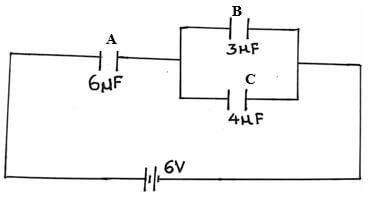
Determine:- Effective capacitance of the circuit (3mks)
- The potential difference across 6µF capacitor (3mks)
- Charge stored in 4µF capacitor (3mks)
- Energy stored in a 4µF capacitor (2mks)
- Fig 12 below shows an isolated positive point charge P

On the figure, sketch the electric field pattern around the charge (1mks)

MARKING SCHEME
SECTION A
- Fig.1 below shows an image of an object reflected on a plane mirror. Using ray diagram, locate the position of the object. (3mks)
- A mirror is rotated through an angle of 15o, find the angle through which the reflected ray is rotated. (1mk)
2 x 15° = 30°
- Fig.1 below shows an image of an object reflected on a plane mirror. Using ray diagram, locate the position of the object. (3mks)
- A strongly charged glass rod is brought close to a neutral electroscope. State and explain the observations made. (2mks)
- Leaf rises/leaf diverges
- The rod repels negative charges / electrons at the leaf and metal plate.
- Fig 2 below shows a circuit made by a form 2 student.

- State and explain the observation made on component Q when switch S closed. (2mks)
- The bulb will not light/component Q will not light
- The voltmeter is connected in series offering very high resistance to the flow of current.
- A current of 1A flows through a circuit for three minutes. Calculate the number of electrons that flows through a point in the circuit. (charge of an electron = 1.6x10-19C) (3mks)
- Q = IT = ne
ne = 1 × 3 × 60
(1.6 × 10-19)n = 1 × 3 × 60
1.6 × 10-19n = 180
n = 180
1.6 × 10-19
n = 1.125 × 1021 electrons
- Q = IT = ne
- State and explain the observation made on component Q when switch S closed. (2mks)
- Fig 3 below show a copper rod placed inside a solenoid.

- State and explain the observation made when the rod is removed after sometime and dipped into a container with iron fillings (2mks)
- The copper rod did not attract the iron fillings Copper is a non-magnetic material hence was not magnetised by electrical method.
- Using domain theory, distinguish between magnetic and non-magnetic materials (1mk)
- Magnetic materials have dipoles aligned in a particular direction during magnetisation while in non-magnetic materials, dipoles cannot be aligned in the same direction during magnetisation.
- State and explain the observation made when the rod is removed after sometime and dipped into a container with iron fillings (2mks)
- Fig 4 below shows rays incident on a curved mirror.

State the rules for drawing the ray 1, ray 2 and ray 3. (3mks)
Ray1 - A ray parallel to the principal axis and reflected through the principal focus
Ray 2 - A ray through the principal focus and reflected parallel to the principal axis
Ray3 - A ray through the centre of curvature and reflected along the same path -
- Define interference as used the waves (1mk)
- Occur when two similar waves of same wavelenght , same frequency are superimposed/ meet/ merge while travelling through the same medium.
- The fig.5 below shows two ways of monochromatic light incident on two adjacent slit S1, and S2

State what is observed on the screen when:- The distance x is increased. (1mk)
- Fringe separation is decreased
- The slit separation d is reduced. (1mk)
- Fringe separation is increased
- The white light is used. (1mk)
- A pattern of different colours is produced.
- The distance x is increased. (1mk)
- Define interference as used the waves (1mk)
- The fig 6 below shows a circuit with a heating element L of resistance 30Ω immersed in a container of water.

- If current in the circuit is 10A and the switch is on for 2minutes. Calculate the heat energy absorbed by the water in kilojoules. (ignore heat gained by the container) (3mks)
- E = I2Rt
=(10)2 × 30 × 2 × 60
=360,000J
- E = I2Rt
- State the adjustment made on the element L so that high temperature is recorded by the thermometer T in the same duration of time. (1mks)
- Using a wire of smaller diameter
- If current in the circuit is 10A and the switch is on for 2minutes. Calculate the heat energy absorbed by the water in kilojoules. (ignore heat gained by the container) (3mks)
SECTION B (55MKS)
-
- A gun was fired at a point 150m from a vertical wall while listening to an echo. The echo coincides with the sound from the gun at each time the gun is fired. After 20 successive shots, time recorded was 18.5seconds. Determine:
- Time taken for one echo to be heard (2mks)
- T = 18.5
20
T = 0.925sec
- T = 18.5
- Speed of sound in air (3mks)
- S = 2D
t
S = 2 × 150
0.925
S = 324.3m/s
- S = 2D
- What difference would you expect if the gun was short on a colder day (1mks)
- Speed of sound would be lower due to lower temp of air
- Time taken for one echo to be heard (2mks)
- Sound is classified as a longitudinal mechanical wave, explain why sound is classified as
- A longitudinal waves (1mk)
- Transmitted in series of alternating compressions and rarefications or direction of propagation is parallel to disturbance.
- A mechanical waves (1mk)
- Require material medium for its transmission
- A longitudinal waves (1mk)
- Fig 7 below shows a progressive waves of frequency 10Hz

Determine the speed of the wave (3mks)- v = fλ
=0.04 × 10
= 0.4m/s
- v = fλ
- Calculate the wavelength of the KBC FM radio wave transmitted at a frequency of 95.6MHz. (v = 3.0 x 108m/s) (3mks)
- λ = v
f
λ = 3.0 × 108
95.6 × 106
λ =3.138m
- λ = v
- A gun was fired at a point 150m from a vertical wall while listening to an echo. The echo coincides with the sound from the gun at each time the gun is fired. After 20 successive shots, time recorded was 18.5seconds. Determine:
-
- The figure 8 below shows a narrow beam of white light passed onto a glass Prism.

- What is the name of the phenomenon represented in the diagram? (1mk)
- Dispersion of white light
- Name the colour at X and Y. (2mk)
X: Red
Y: Violet - Give a reason for your answer in part (ii) above.(2mks)
- Red has the lowest frequency /longest wavelength hence least deviation while violet has high frequency /short wavelength hence more deviation.
- What is the purpose of the slit? (1mk)
- Act as a point source of light
- What is the name of the phenomenon represented in the diagram? (1mk)
- Figure 9 below shows the path of ray of yellow light through a glass prism. The speed of yellow light in the prism is 1.8 x 108 m/s.
- Determine the refractive index of the prism material (Speed of light in vacuum, C= 3.0 x 108 m/s)(3mks)
- n= speed in air
speed in material
= 3.0 × 108
1.8 × 108
n = 1.6667
- n= speed in air
- Given that r = 31.20, determine the angle θ. (3mks)
- n = sin i
sin r
1.6667 = sin θ
sin 31.2
sin θ = 1.6667sin31.2
θ=sin-10.8634
θ=59.7º
- n = sin i
- Show on the same diagram, the critical angle c and hence determine its value. (3mks)
- see c on the diagram
sin c = 1
n
= 1
1.6667
sin c = o.5999
c = sin-10.5999
c = 36.86º
- see c on the diagram
- Determine the refractive index of the prism material (Speed of light in vacuum, C= 3.0 x 108 m/s)(3mks)
- The figure 8 below shows a narrow beam of white light passed onto a glass Prism.
- Fig 10 below shows a circuit in which a bulb. A resister R, a voltmeter V, a light dependent resistor(LDR) and ammeters A1 and A2 of negligible resistors are connected

R has a resistance of 8Ω when the switch is closed with no source of light. Ammeter A2 reads 0.12A while the voltmeter reads 2.4V- Determine;
- The current passing through R (2mk)
- I = V
R
=2.4
8
=I = 0.3A
- I = V
- The resistance of the bulb (2mks)
- R = V
I
=2.4
0.12
=20Ω
- R = V
- The current passing through R (2mk)
- Light is now shone onto the Light Dependent resistor (LDR)
- State how this will affect the reading of ammeter A1 (1mk)
- The current /ammeter reading increases
- Explain your answer in b) (i) above (2mks)
- More light on LDR lowers the resistance of the LDR hence more current flows /ammeter reading increases
- State how this will affect the reading of ammeter A1 (1mk)
- If the LDR has a resistance of 10Ω at room temperature, determine:
- The total resistance in the circuit at room temperature (2mks)
- Resistance (Bulb +R) in parallel
= 8 × 20
8 + 20
= 5.7143Ω
Total resistance = 5.7143 + 10
= 15.7143Ω
- Resistance (Bulb +R) in parallel
- The voltage across the LDR (3mks)
- Total current = 3
15.7143
=0.19009
V=IR
V = 0.19009 × 10
= 1.9009V
- Total current = 3
- Name one application of light dependent resistor(LDR) (1mk)
- Light operated switching circuit
- street lighting
- burglar alarms
- The total resistance in the circuit at room temperature (2mks)
- Determine;
-
- Explain how negatively charged electroscope gets discharged when the cap is touched with a finger. (1mks)
- The body provide conducting path and electrons flow to the earth
- Fig.11 below show a capacitor A,B,C connected as shown with a battery of e.m.f 6V

Determine:- Effective capacitance of the circuit (3mks)
- capacitor in parallel
c1 + c2
3uf + 4mf
=7mf
series = 1/6 + 1/7
=6 × 7
6 + 7
= 3.231mf
- capacitor in parallel
- The potential difference across 6µF capacitor (3mks)
- Q = cv
=3.231 × 10-6 × 6
=1.9386 × 10-5c
v = Q
c
=1.9386c
6.0 × 10-6
= 3.231v
- Q = cv
- Charge stored in 4µF capacitor (3mks)
- Q = cv
voltage across 4NF
=(6 - 3.2307)v
=2.76923v
Q = 4 × 10-6 × 2.76923
=11.076972mc
or
= 1.107692 × 10-5
- Q = cv
- Energy stored in a 4µF capacitor (2mks)
- E = 1 cv2
2
= 1/2 × (4 × 10-6) × (2.76923)2
=1.5337 × 10-5J
- E = 1 cv2
- Effective capacitance of the circuit (3mks)
- Fig 12 below shows an isolated positive point charge P
On the figure, sketch the electric field pattern around the charge (1mks)
- Explain how negatively charged electroscope gets discharged when the cap is touched with a finger. (1mks)
Download Physics Paper 2 Pre Mock Questions and Answers - Mokasa I Joint Examination July 2021.
Tap Here to Download for 50/-
Get on WhatsApp for 50/-
Why download?
- ✔ To read offline at any time.
- ✔ To Print at your convenience
- ✔ Share Easily with Friends / Students

